Podcast
Questions and Answers
What percentage of all individual animals do nematodes account for on Earth?
What percentage of all individual animals do nematodes account for on Earth?
- 20%
- 50%
- 90%
- 80% (correct)
How many major clades are nematodes divided into based on SSU rRNA phylogenetics?
How many major clades are nematodes divided into based on SSU rRNA phylogenetics?
- Four
- Six
- Five
- Two (correct)
Which of the following is NOT a major clade within the Nematoda?
Which of the following is NOT a major clade within the Nematoda?
- Chromadorea
- Enoplia
- Rhabditida (correct)
- Dorylaimia
How many nematode-specific protein families were identified in a transcriptomic analysis of the phylum Nematoda?
How many nematode-specific protein families were identified in a transcriptomic analysis of the phylum Nematoda?
What ecological niches have nematodes evolved to exploit?
What ecological niches have nematodes evolved to exploit?
What role has the transition from free-living to parasitic lifestyles played in nematode diversification?
What role has the transition from free-living to parasitic lifestyles played in nematode diversification?
Where do nematodes occupy a wide range of ecological niches?
Where do nematodes occupy a wide range of ecological niches?
Which nematodes are obligate parasites of terrestrial and marine arthropod hosts?
Which nematodes are obligate parasites of terrestrial and marine arthropod hosts?
What type of data has led to a more nuanced understanding of nematode phylogeny?
What type of data has led to a more nuanced understanding of nematode phylogeny?
What remains unresolved within many lineages of the phylum Nematoda?
What remains unresolved within many lineages of the phylum Nematoda?
Which classification divides Nematoda into Aphasmidia/Adenophorea and Phasmidia/Secernentea?
Which classification divides Nematoda into Aphasmidia/Adenophorea and Phasmidia/Secernentea?
Heligmosomoides polygyrus bakeri is a parasite of which organisms?
Heligmosomoides polygyrus bakeri is a parasite of which organisms?
Flashcards are hidden until you start studying
Study Notes
Phylum Nematoda: A Diverse Group of Organisms
The Nematoda, also known as nematodes or roundworms, are a highly diverse group of organisms that have evolved to exploit a wide range of ecological niches. As the second most abundant multicellular organisms on Earth, nematodes account for approximately 80% of all individual animals. With estimates ranging from 100,000 to 1 million extant species, the phylum Nematoda is one of the most diverse groups in the animal kingdom.
Nematode Clades
Nematodes can be divided into three major clades based on small subunit ribosomal RNA (SSU rRNA) phylogenetics: Dorylaimia (clade I), Enoplia (clade II), and Chromadorea. Chromadorea can further be divided into Rhabditida, which includes Spirurina, Tylenchina, and Rhabditina. All major clades within the Nematoda include both free-living and parasitic species.
Parasitism and Nematode Evolution
Parasitism in Nematoda has arisen multiple times throughout their evolution, with all major clades including parasites. The transition from free-living to parasitic lifestyles has been a significant factor in the diversification of nematode species.
Nematode-Specific Protein Families
A transcriptomic analysis of the phylum Nematoda identified more than 2,600 different known protein domains, some of which had differential abundances between major taxonomic groups of nematodes and 4,228 nematode-specific protein families that probably underpin species- and higher-level taxonomic disparity. These nematode-specific families are particularly interesting as potential drug and vaccine targets.
Nematode Ecology and Habitats
Nematodes occupy a wide range of ecological niches, from free-living microbivores to human parasites. They exploit various habitats, including terrestrial, marine, and freshwater environments. Some nematodes, like Gordioidea and Nectonematoidea, are obligate parasites of terrestrial and marine arthropod hosts, while others, like Heligmosomoides polygyrus bakeri, are parasites of animals and humans.
Nematode Phylogenetics and Classification
Phylogenetic relationships within many lineages of the phylum Nematoda remain unresolved, despite numerous morphology-based and molecular analyses. The most widely accepted morphology-based classification divides Nematoda into Aphasmidia/Adenophorea and Phasmidia/Secernentea. However, molecular data, such as small subunit ribosomal RNA (SSU rRNA) sequences, have led to a more nuanced understanding of nematode phylogeny.
In conclusion, the phylum Nematoda is a highly diverse and successful group of organisms, with a wide range of ecological niches and numerous phylogenetic relationships. The field of nematode research continues to evolve, with new discoveries and analyses shedding light on the complex and fascinating world of these roundworms.
Studying That Suits You
Use AI to generate personalized quizzes and flashcards to suit your learning preferences.




